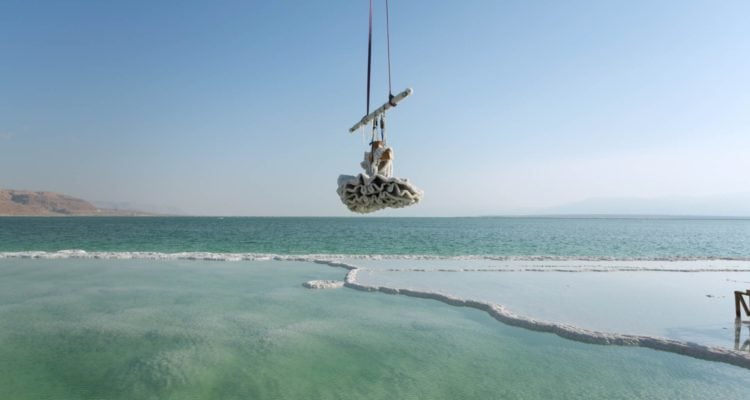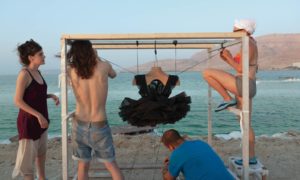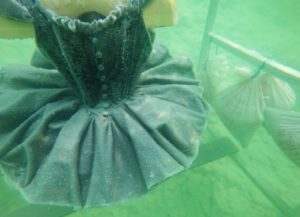Landau and her team submerged objects ranging from a tutu to a cello in the mineral-rich lake and documented their crystallizing transformation.
By Abigail Klein Leichman, Israel21c
An 11-minute video of renowned Israeli artist Sigalit Landau floating naked on the Dead Sea within a slowly uncoiling spiral of 500 watermelons made a big splash in the art world in 2005.
The Dead Sea has beckoned Landau to return again and again from her Tel Aviv studio since 2003.
Called the “Salt Sea” in Hebrew, and actually a lake, the Dead Sea is the lowest continental surface on Earth. It is hailed for its healing powers and mined for cosmetics and industrial products.
Landau and her team submerged objects ranging from a tutu to a cello in the mineral-rich lake and documented their crystallizing transformation.
“Magical moments happen under the water, so my co-creator Yotam From followed the process through underwater photography,” Landau explains.
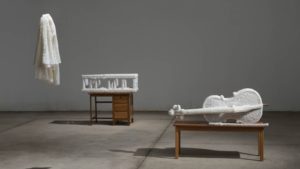
“When I Go, 2017” — readymade objects (double-sided stool, cello, bow, woodenstool, bridal veil) coated in salt crystals, on readymadefurniture, studio installation views. (Yotam From, ©Sigalit Landau, 2019)
Salt Years is a newly published pictorial and prose salute to Landau’s unique artistic genre.
“Her art pieces are cultivated with salt crystals, like an oyster farm, using an organic process to transform mundane, everyday, usually useless artifacts into objects of mesmerizing, haunting beauty,” writes editor David Goss in his introduction.
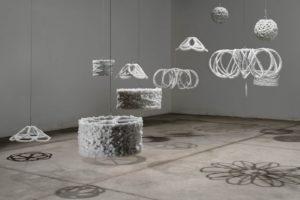
“Strand, 2017” — Barbed-wire lampshades and coils coated in salt crystals,studio installation views. (Yotam From, ©Sigalit Landau, 2019)
Landau tells ISRAEL21c that her jaunts to the Dead Sea began from a place of memory and vision.
As a child in 1970s Jerusalem, she and her family often took an hour’s drive down to the salty shores. As an artist, she saw amazing potential for expression.
“I was fascinated by the combination of the crystals’ formal beauty and the fact that I can come up with something like a postcard. My grandfather had a big shop where he used to sell postcards,” she explains.
A wire postcard display stand is among the objects she and her team “baptized” in the lake.
“We put in about 10 objects, chosen from over 100 through trial and error,” she says. “I had some grand failures – some things were too big or too small.”
A black tutu was a big success. The following photos show the progression from pre-submerging to finished product.
Landau handmade crocheted baby booties and a tapestry challah cover to dip into the Dead Sea.
Pulled up from the water after a few weeks, the objects are encrusted in a way that simultaneously destroys their original purpose and preserves them as works of art.
In the summer of 2014, they submerged a thick black dress reminiscent of the wedding gown worn by Israeli actress Hanna Rovina portraying the young demon-possessed Russian bride in the 1922 Yiddish play “The Dybbuk.”
Salt Years has 400 pages filled with images as well as essays by curators, scientists, philosophers and artists including Landau herself.
In her essay, she laments the rapid depletion of the Dead Sea, mostly due to human interventions.
Her dream project is “a salt-crystal bridge that would take the form of a pier or a float and serve as both a passageway and a meeting point within the Dead Sea’s extraterritorial waters” connecting Israel and Jordan.
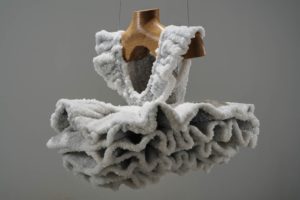
“Tutu, 2018” — Tutu dress suspended in the water of the Dead Sea. (Yotam From, ©Sigalit Landau, 2019)
“Using methods that I have been developing for over 15 years, massive, beautiful salt crystals will gradually grow upon a core structure. Starting from the center of the lake, it will gradually expand both eastward and westward, until it reaches both shores.”




